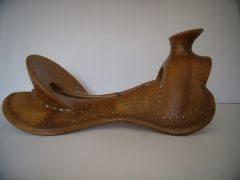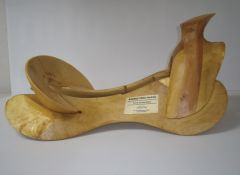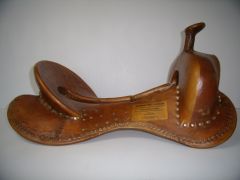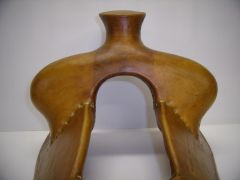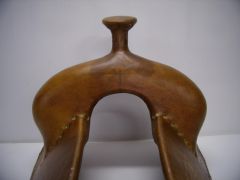-
Posts
423 -
Joined
-
Last visited
Content Type
Profiles
Forums
Events
Blogs
Gallery
Everything posted by Rod and Denise Nikkel
-
Huntet, You are feeling with your hand between the horse and saddle subjectively to see if the pressure on your hand from the saddle is the same all the way down the bar. There may be no contact at all in the center if you have a really badly bridging saddle. Check with your hand under the front and back bar tips as well. Is there more pressure there? Then push down on the saddle while your fingers are under the bar tips. If you are feeling a lot of pressure there, so is she. The pressure should ease off gradually from under the saddle, not have a sharp edge that digs in. If you still have questions, then have someone walk the horse as you have your hand in the area you wonder about. The tree will have more and less pressure under different parts as they walk. The question is does it have too much at any point. Remember that what you are feeling is just the weight of the saddle. The pressure increases a lot with the rider. Once you know where the bar edges and tips were resting on her during your ride, check for soreness in those areas specifically. Don't just push down on the muscles. That is only part of what may show you pain. Push sideways towards the spine and watch for her reactions. Normal muscle doesn't hurt even with a fair amount of pressure. She may wonder what you are doing but that reaction is different than "ouch!". You'll be able to tell.
-
Huntet When you have a chance, put the saddle on her with no pad and run your hand under the bar all the way down her back. She looks to have a fair amount of rock in her back and if the bars don't have much rock, she could be bridging badly - contact only or mainly at the front and the back. If you put her on an uphill climb, those back bar tips could be digging into that rise she has in the loin area pretty hard depending on how they are shaped. That is enough pain to cause a lot of horses to buck. Everyone worries about the shoulders but those back bar tips can do a lot of damage too if they dig in. Is she sore anywhere if you put pressure down her back and in toward the spine? Especially check where the bar tips would be - front and back. Comparing your two saddles - no, the cinch is not going to hang in the same place on these two, and there is nothing wrong with that.
-
Hunter, The idea that there is a "right" place for a cinch is one of the fallacies about saddle fit that is commonly taught. So long as the cinch is on the breast bone and not behind it, it doesn't matter where on the breastbone it sits. The shape of your horse will determine where it sits since it will move to where it fits regardless of where you place it. It DOES NOT have to hang vertical. The idea that the cinch placement has an effect on where a good fitting saddle fits is also a fallacy. If the shape of a saddle fits the shape of a horse (think two spoons nestled together), it will move to the spot it was intended to fit and stay there regardless of what angle the cinch is at. A forward angled cinch is NOT going to pull a GOOD fitting saddle forward. Nor will a cinch hold a good fitting saddle too far forward. It will move back to where it fits, and then stay there with a forward angled cinch. On the other hand a poorly fitting saddle is going to move around because the shapes just don't match (think spoon on fork or knife). The cinch may then affect where the saddle ends up. So if the rigging and cinch position do affect where your saddle ends up, it is a good sign that the saddle doesn't fit well. In your case, either 1.) you are expecting the saddle to stay farther forward than it is made to sit or 2.) it doesn't fit well and so it moves around, or a combination of the two. From the reaction of your horse, I would expect #2 to be at least part of the problem. The most helpful would be pictures of the way you normally saddle and where you place your saddle, what happens after the horse moves around so we can see where it ends up, and at least a side view of your horse without the saddle so we can see the basic shape of the horse. What style of saddle were you riding before?
-

Seminar On Trees
Rod and Denise Nikkel replied to Rod and Denise Nikkel's topic in General Saddlery Discussion
Not sure how many saddle makers there are. Full time, part time or "make them in my basement in the winter on occation" time, there would add up to being quite a few. I think most would live in the south half of Alberta, BC and Saskatchewan. There are a few shows around trying to highlight the gear maker's work for the public: Kamloops, one in Calgary a few years back (is that still running?) and Andy Fadeeff has been organizing one for the last few years at Northlands during the finals. But nothing we know of like a trade show geared toward all leatherworkers, especially saddlemakers, that has leather and tools, etc. If something like that was put on in the Calgary area, especially around the time of the Stampede, I can see it drawing a lot of people even from south of the border. I don't know what it would take to get the vendors up here though since a lot of them would have to cross the line to come up and there are probably a lot of hurdles to jump to sell up here, same as going the other way. It sure would be nice to have something like that up here too though, and I think it would do OK. -

Seminar On Trees
Rod and Denise Nikkel replied to Rod and Denise Nikkel's topic in General Saddlery Discussion
I don't think there is anything like that in Canada at all. I think if someone wanted to put one on in the Calgary area it would work well. But I don't know of anyone up here who wants to do something like that. -

Blackfeet Saddle?
Rod and Denise Nikkel replied to Rod and Denise Nikkel's topic in Saddle Supplies, Tools & Trees
I knew this would be the best place to ask! Thanks for the info and the links and if anyone has any more, please keep them coming. Knut, I couldn't get your second link to work. Does it work for you? The pictures on that site are great Chuck. Lots of variation in the shaping of the fork and cantle (for lack of proper terminology). This one has the shape of some that are called pack saddles in the Plain's section of that site, but none of the pack saddles have the hook out the front like the women's riding ones do. Great saddle history on these from the Smithsonian site. The men's saddles were totally different than what the women rode, and it was the women who were the saddle makers. Interesting... -
We were sent this picture by a customer wondering about having a tree like this made. Apparently the picture is from the internet somewhere (I don't know where) and this is all the information he has. The picture is labeled "blackfeetsaddle". Does anyone know anything more about these trees/saddles? Pictures from other angles would really be helpful too if anyone else can find them. I'm not having much sucess. Thanks!
-

Sheridan Show Classes
Rod and Denise Nikkel replied to TimKleffner's topic in Special Events, Contests and Classes
When you call the Holiday Inn, be persistent in getting them to check for open rooms. I called last week and was told there were no rooms and there was nothing booked for Leathercrafters, so I booked at the Mill Inn instead. ($55.00 per night at the LC rate.) I called Holiday Inn again today just to double check and was again told there were no rooms. When I persistently asked about Leathercrafters, she did eventually find the open rooms. She said "I never look at that screen." So be persistent, and there is one more room available than there would have been if the clerk was well trained... -

Sheridan Show Classes
Rod and Denise Nikkel replied to TimKleffner's topic in Special Events, Contests and Classes
We will be there. Talked to David Reis at LCSJ today and we will have a booth in the atrium area, sounds like close to the end with the resaurant. Looking forward to meeting people and putting some faces to names. -

My Images On Ebay
Rod and Denise Nikkel replied to Steve Brewer's topic in All About Us and Off Topic
Luis, In your post directed to me you wrote "I do my own work". Yet in your e-mail to us you said "here is a couple of pics of my saddles As you can see I try to do my best". The pictures you sent with that e-mail were NOT your own work. The reiner was built by Shelly Liggett and I have just confirmed that the Wade was indeed built by Perry Ward from Rafter W saddles. He told me the picture was taken in his shop 3 years ago. I am not attacking you Luis. I am simply telling the truth. Stealing pictures off the internet is stealing, and saying you made something you didn't is lying. I'm sorry if your wife has cancer and if things are tough for you. If you can make a decent saddle and sell it honestly, then that is how you should make your living. But don't steal and don't lie, as you are continuing to do. Denise -

My Images On Ebay
Rod and Denise Nikkel replied to Steve Brewer's topic in All About Us and Off Topic
Luis, It appears you have been making the same “terrible mistake” for a long time. In June 2008, “Louis Carrillo” sent us an e-mail with two pictures to show us “your work”. Looking at this thread made me curious and I did some checking. I have attached the pictures you sent below. The reining saddle was actually made by Shelly Liggitt. I sent her the image and I just got off the phone with her. This was one of the pictures you put up on E-bay, selling “your” saddle with her pictures. She reported you then and yet you are still doing the same thing now. Who is the real maker of the Wade, Luis? Or does anyone else know the real maker of it? -

Seminar On Trees
Rod and Denise Nikkel replied to Rod and Denise Nikkel's topic in General Saddlery Discussion
Thanks for the comments and the votes everyone. At this point this is in the idea stage only. How, when and if ever are all still up in the air so we appreciate any and all input. -
Rod and I have been tossing around the idea of putting together a short seminar on trees from a tree maker's perspective. Things we would talk about would include: 1.) Measuring a tree: what different measurements used, what they tell you and what they don't, what you can measure on a finished tree and what you can't, etc. 2.) Getting the looks you want in the different components of a tree: a.) Fork – what factors affect the shape and how. b.) Horn – wood versus metal, factors that affect the look and why. c.) Cantle – the three slopes in every cantle and how they relate, factors that affect the shape and how they interact with dish, a bit about angles. 3.) Components of tree construction that affect the fit for the horse and how. 4.) Evaluating a horse for saddle fit – what you look at and why. We are trying to gauge the level of interest in such a seminar if it were possible, so your input via the above poll would be appreciated. Also, what other questions/topics would you like to see addressed in such a seminar?
-
I spent some time this morning typing out the following post, then got on here and read Newfman’s post. Interesting… The idea that one saddle can be specifically shaped to fit one particular horse is what a lot of owners have in their minds as a "custom fit saddle". I have wondered where this idea comes from, since it certainly isn't from the people who work from their saddles on multiple horses, nor is it from the western saddle making industry. The one thing people on this forum seem to be unanimous on is that we don't want to build one tree or saddle for one specific horse. I believe this idea probably comes from the world of English saddles where the panels are stuffed with wool and that stuffing can be changed, within limits, to accommodate the idiosyncrasies of an individual horse. The original "saddle fitters" would have been the saddlers who did the stuffing. Now there are people who don't make saddles (therefore their understanding of how they work is often less extensive) but who restuff them. And there is the whole area of CAIR and FLAIR saddles where the panels have air rather than wool and the air pressure in some of these panels can be varied, supposedly to "custom fit" the saddle by a "saddle fitter". If you want to use that saddle on another horse regularly, the current idea is that you NEED to restuff or change the air in them to fit that horse as opposed to the last one, so you NEED a "saddle fitter" to make sure your saddle will work on THIS specific horse. (I can see where the promotion of that idea may come from too.) And, like a lot of the "saddle fit rules", this idea of what a "custom made saddle" is has been transferred over to western saddles even though it does not apply. Once built, a western saddle has a shape that doesn't change. All western "saddle fitters" can do, so far as I can tell from reading the net, is either arrive with a trailer load of saddles to try on and figure out which one will work best for that horse or work with pads and/or shims to account for the idiosyncrasies in each horse's back. (The advisability of doing this, the competence of the people involved, etc. etc. is a whole other topic I'm consciously staying away from here.) So a "custom fitted" western saddle is simply one that has been evaluated by somebody who says that the basic shape of this saddle matches the basic shape of this horse. This is what saddle makers, tree makers, and competent horsemen do all the time and why people who fit into the "working camp" of Bob's post generally don’t have much use for the idea of saddle fitters or custom fit saddles. On the other hand, the "recreational camp" people often don't have the experience to judge the shapes well, and are more likely to believe the "one shape to fit one horse" idea that is being perpetrated in the horse world these days, not understanding where it has come from. And once that idea is ingrained in someone's head, it is hard to get them to see beyond it to the much simpler concept that matching shapes (following the two rules of "don't dig in anywhere" and "maximum surface area without breaking rule #1") is all that is needed. But the other side is also true. One size (or shape) does not fit all horses, and in some areas that is not yet recognized either.
-
Bingo! The ideal fit is when the horse is at the middle of the range of horse shapes which that tree would work on, and that is what we aim at when someone wants a tree for a specific horse. When they are looking to ride a number of horses, we try to figure out the general range that will be needed and hit the middle of that, though that is more commonly done verbally than with back drawings etc. A couple points I would like to highlight in terms of "fitting a range" though. First, you need a well designed tree, which means that it doesn't dig in anywhere along its entire length. (There is not a lot of talk about fitting anything other than withers in the lay person world, and the rest of the tree is just as important.) If it doesn't have relief on the edges and tips, etc. it won't work even if the middle of the range the width and angle, etc. are correct. Second, you need adequate surface area. Narrow short bars may work OK if they are really dead on for fit. They don't have much range though because they need all that surface area to distribute the weight sufficiently and if they lose partial contact due to varying horse shape they may produce high pressure areas just due to lack of adequate surface area on the horse. (I would suggest there is a difference in these two factors between true hand made trees and production models. But then, every tree maker thinks a bit differently too!)
-
Thought we better pop in here to clarify a possible misconception. There is a common idea out there that when a tree maker gets a mold or numbers from the DL system or back drawings or whatever else that they make an exact copy/negative/inverse for the bottom of the bar to fit that horse. This is NOT what we do. We simply use the information given to know what general type or shape of horse it represents and then use whatever combination of hand hole width, bar angle, rock, crown, etc. that is needed to fit that type of horse. We don't build trees to fit one specific horse - only the type of horse that represents - so the saddle can be used on other horses of that type. And with adequate surface area on the bars, it will also fit a range of horses on either side of the "ideal" type. Even though it will sit higher or lower on some horses, it will not dig in anywhere (no high pressure points) and will still have adequate surface area contacting the horse (even with some of the bar not contacting) to distribute the weight decently. This is how a well designed tree can be used on a lot of horses. If an owner has an individual horse, then using these systems is a good way to get us the information on that horse's shape, since "big and wide" can mean different things to different people, or the owners simply don't know enough to describe their horses properly. A case in point: We were at a place that raised and trained Tennessee Walking Horses and we were using Dennis Lane's system to check their back types for our own benefit. As we checked out a mare the handler commented that they had no problems fitting a saddle to this horse as she was pretty wide so the "normal" saddles fit her well. Looking at the horse (and confirming our ideas with the DL cards) we would agree that our most common combination would work on this mare. Then they brought in a gelding telling us how hard a time they had fitting this horse because he was so narrow. Looking at his chest from the front, he was much narrower than the mare. But his back carded the same! The reason they were having problems fitting this horse was they were looking for a narrow saddle for a horse that wasn't narrow in the back! And these were people who had been in the equine business for a lot of years. So if they couldn't evaluate a back well, how can we expect an individual horse owner to be able to tell us what we need to know? Most saddle makers have spent a fair amount of time throwing trees on horses and evaluating what they see and then how well they work in the finished saddle. So they get to know how "such and such" tree specs from a specific maker will work on this type of horse. If they know their customers and the common type of horses ridden at that ranch or barn or even in the area in which they live, then they can make a good judgment call on what to order. I'm attaching pictures of three horses below here to maybe illustrate. The bay with the white shoulder is a pretty middle of the road horse. He fits right into the middle of the bell curve of horse shape variations and there are a lot of horses out there like him. He would do OK in more than one of our common combinations of width and angle and our "normal" rock, though we chose the combination we thought was ideal. And the tree built for this order will fit a lot of other horses out there. Trees built for the dark brown and the gray, however, won't fit much of a range of shapes since they are already at the far edges of the bell curve of variations. They will, however, fit the relatively low percentage of other horses of this type/shape. And since both owners are committed to their specific breed and discipline, the chance of them having another horse of this shape is fairly good. Should you build for the ends of the bell curves? That is a question to be answered by individual makers. But even building for an "end of the bell curve shape" is a different question than building for an individual horse and his idiosyncrasies. Hopefully this helps demonstrate the difference. (And yes, other factors than the tree or even the saddle affect the horse's back and need to be considered. But the tree and saddle DO affect the horse's back!)
-

Wade Tree Side View Rod Nikkel Saddle Trees
Rod and Denise Nikkel posted a gallery image in Our Leatherwork Galleries
From the album: Rod Nikkel Saddle Trees
Wade tree side view. 5" stock thickness.© © leatherworker.net
-

Rod Nikkel Saddle Trees
Images added to a gallery album owned by Rod and Denise Nikkel in Our Leatherwork Galleries
-

Wade tree in the wood Rod Nikkel Saddle Trees
Rod and Denise Nikkel posted a gallery image in Our Leatherwork Galleries
From the album: Rod Nikkel Saddle Trees
Wade tree in the wood. 5" stock thickness© © leatherworker.net
-

Swell Fork side view Rod Nikkel Saddle Trees
Rod and Denise Nikkel posted a gallery image in Our Leatherwork Galleries
From the album: Rod Nikkel Saddle Trees
Swell fork with normal amount of forward lean. Modified Association. 3 3/4" stock thickness.© © leatherworker.net
-

Swell fork stood up side view Rod Nikkel Saddle Trees
Rod and Denise Nikkel posted a gallery image in Our Leatherwork Galleries
From the album: Rod Nikkel Saddle Trees
Stood up swell fork. High Country 3 3/4" Stock Thickness© © leatherworker.net
-
From the album: Rod Nikkel Saddle Trees
Stood up swell fork (High Country) in the wood. 3 3/4" Stock Thickness© © leatherworker.net
-

Wade 10" Rod Nikkel Saddle Trees 0706071
Rod and Denise Nikkel posted a gallery image in Our Leatherwork Galleries
-

Wade 9 1/2" Rod Nikkel Saddle Trees 0610121
Rod and Denise Nikkel posted a gallery image in Our Leatherwork Galleries
-

Wade 9" Rod Nikkel Saddle Trees 0705045
Rod and Denise Nikkel posted a gallery image in Our Leatherwork Galleries









